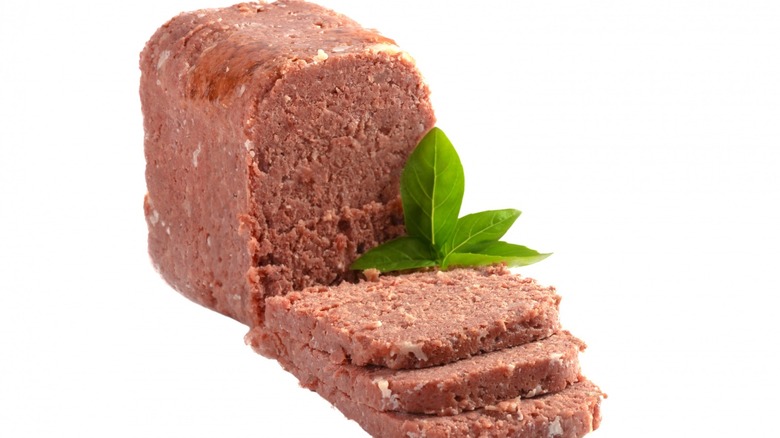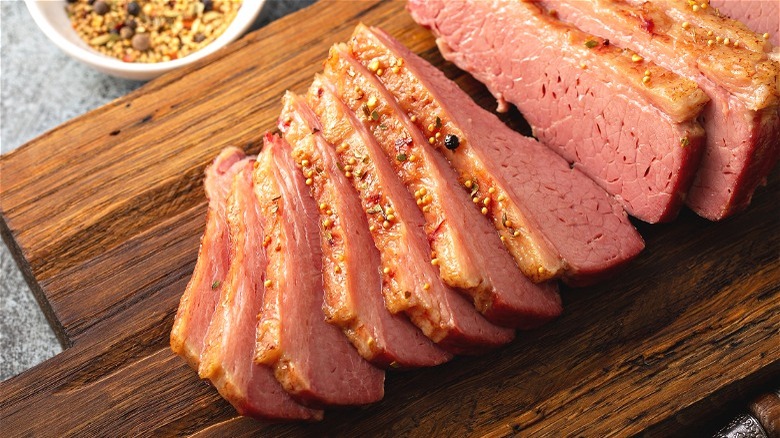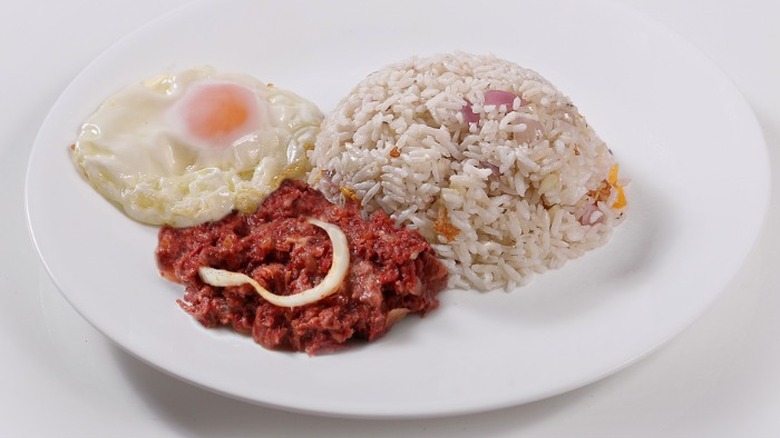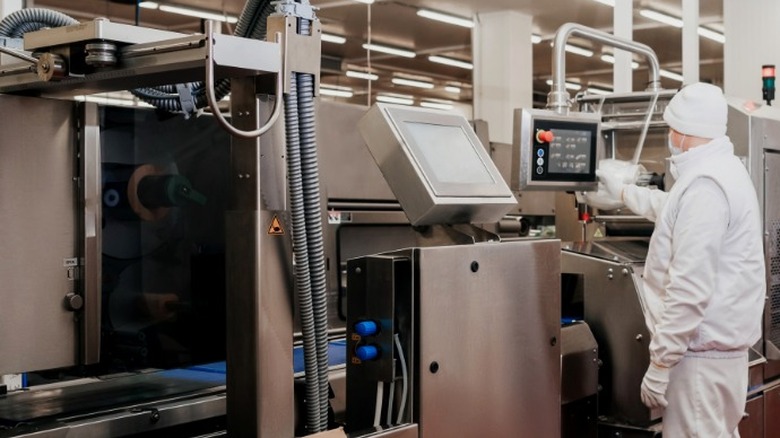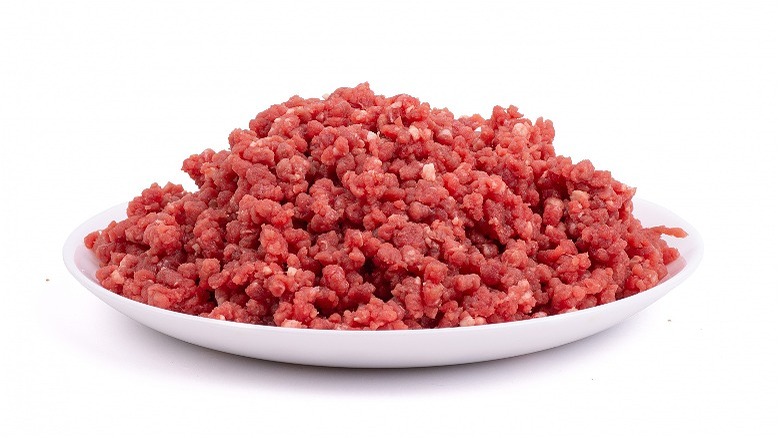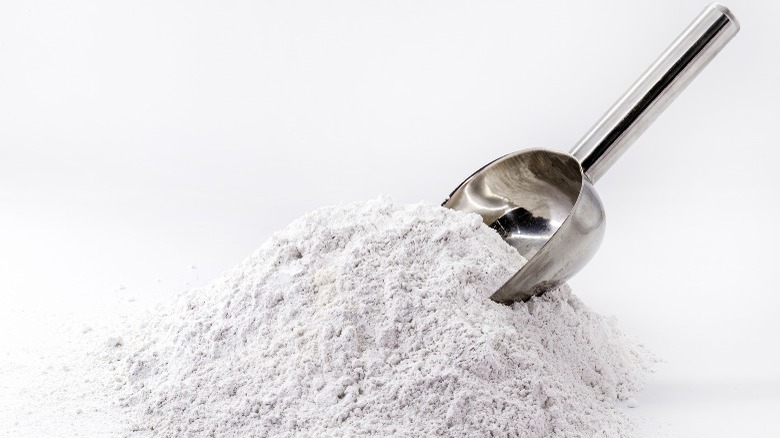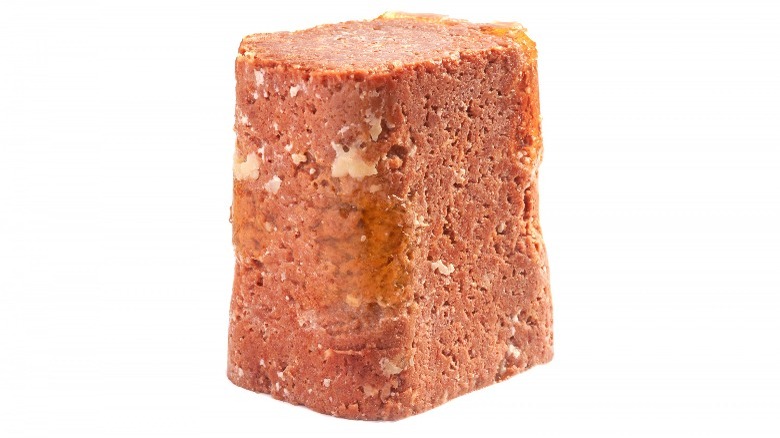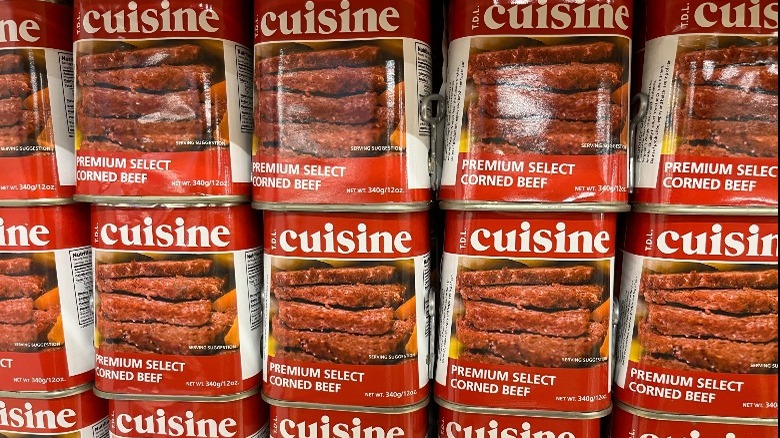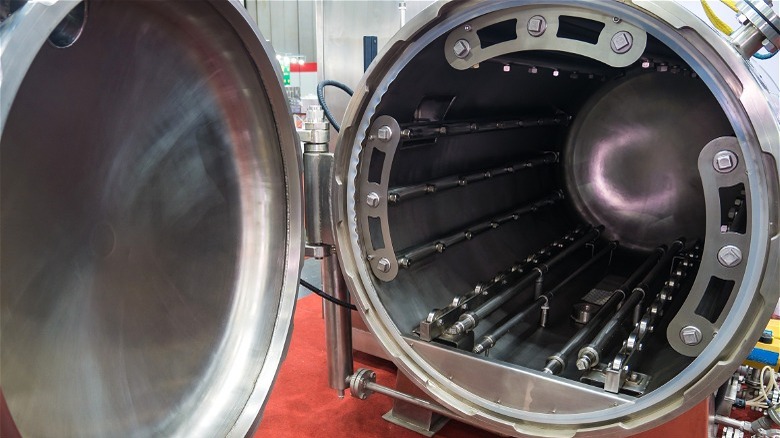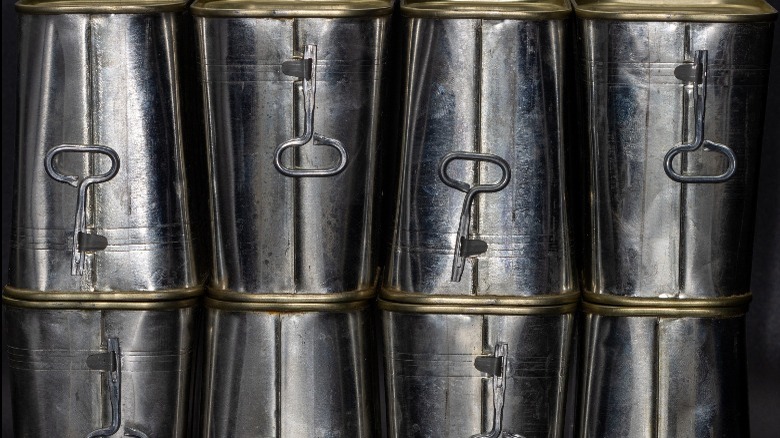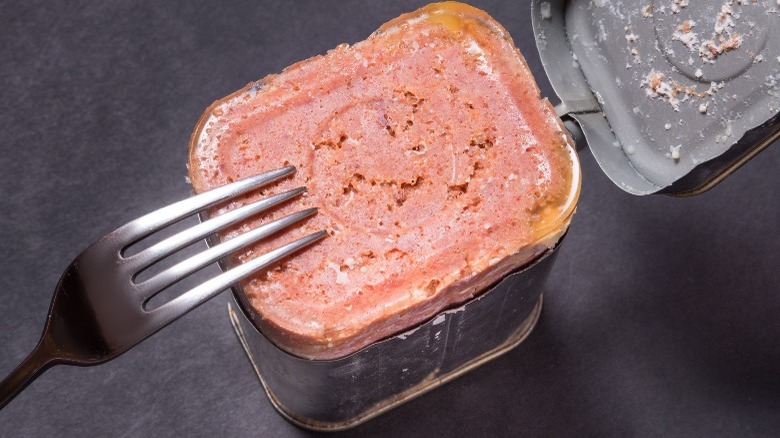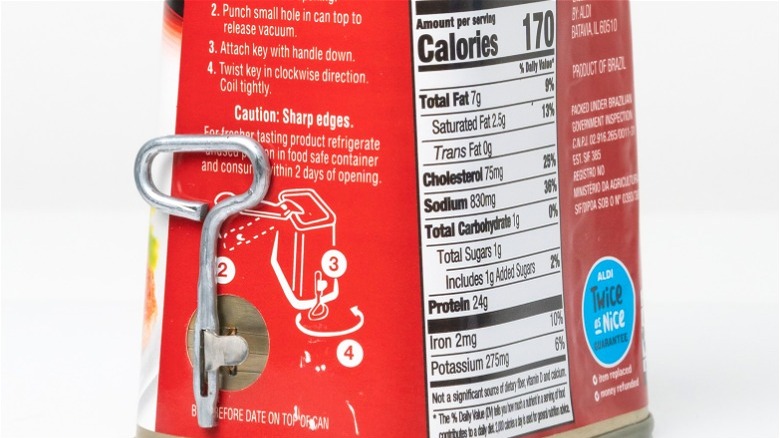This Is How Canned Corned Beef Is Really Made
We may receive a commission on purchases made from links.
Many know corned beef as the protein served alongside cabbage during St. Patrick's Day celebrations. With this traditional dish, freshly cooked beef brisket is served in slices. In the past, this brisket would be preserved using "corns" of large salt, per the University of Minnesota Extension, which is how corned beef got its name. Today, we have refrigerators, so this salt preservation method is less necessary. However, to make long-lasting canned corned beef, steps are taken to extend its shelf life.
The beginnings of canned corned beef production have been traced to the 1800s. At that time, countries were experimenting with ways to feed their soldiers (via the Sarasota Herald-Tribune). They found success with tinned beef. This ration was convenient because it was full of protein, wouldn't spoil for long periods, and could be eaten straight from the can (via Food Timeline). Canned corned beef was referred by its British nickname, "bully beef," inspired by the fact that it's boiled before canning. Thanks to these trailblazers, boiling remains part of modern-day canned corned beef production.
However unappetizing some people may find it, canned corned beef is a regular staple in many households. You can find popular brands like Libby's, Hereford, or Hormel at your local grocery stores. But even though this food has a centuries-long history, people may not know what goes into producing it. To find out how canned corned beef is really made, read on.
Most of the world's supply comes from Brazil
Brazil plays a large role in the canned corned beef industry. Per Very Meaty, this is partly because it has ample land for cattle grazing. Also, canned corned beef production can work in conjunction with the production of other beef products. This is convenient because Brazil makes a lot of beef. In 2020, Brazil ranked second among countries with the highest rates of beef production — just behind the United States. According to one report, the South American nation is responsible for producing about 80% of the world's tinned meat.
Some of the biggest canned corned beef companies have ties to Brazil. Libby's, an American company that is one of the most recognizable suppliers of its kind in the U.S., makes some of its products in Brazil. You can see this stated on Libby's packaging. The same goes for the company Exeter. Princes, another British maker of the product, also had ties to Brazil. JBS, the parent company of canned corned beef maker Hertford Fine Foods, is also based in Brazil.
However, Brazil's predominance in this industry may be shifting. Starting around 2017, reports concerning canned corned beef maker JBS tied the company to illegal deforestation and labor violations. Some said that JBS employees were working under slave-like conditions (via Earthsight). Since the company has additional connections to other canned corned beef makers such as Princes, Exeter, and Simmenthal, boycotts of these products have resulted (via Mighty Earth).
It's not necessarily made from brisket
The type of meat is one of the ways that canned corned beef distinguishes itself from the fresh stuff. The cut of beef chosen for the tinned product isn't the same as what you'd buy at a deli counter. While both canned and non-canned corned beef come from cows, they use different parts of the animal. As Science Direct explains, traditional corned beef uses a cut called brisket. This meat comes from the cow's chest area. But canned corned beef isn't always made from brisket.
According to EHow, this is because tough, lean cuts of meat — such as round steaks, chuck roasts, or ribs — work best for canning. Per Very Meaty, canning meat also requires that as much fat as possible is removed. If too much fat is left in, it can cause multiple issues. As Healthy Canning explains, excess fat in canned meat can cause problems with rancidity, sealing, and heat penetration. This is why canned corned beef makers may not select fattier, more expensive cuts of beef (like brisket) for their choice of meat.
In the Philippines, it's sometimes made from buffalo meat
Even though the name would imply otherwise, canned corned beef does not always come from a cow. This pantry food is popular all over the world, partly because it's a shelf-stable product that can be enjoyed by those without refrigeration (via ScienceDirect). Along with South America, North America, and Europe, Southeast Asia is also a popular place for canned corned beef. The food is especially popular in the Philippines.
Within Filipino cuisine, you'll find many canned corned beef recipes. One is a breakfast dish consisting of white rice, fried eggs, and canned corned beef. Other times, canned corn beef is put into spaghetti, where it's used to create a meaty tomato sauce. The meat itself is a little different in this country. In the Philippines, canned corned beef is often shredded. Also, it's sometimes made from buffalo, a common species in the Philippines. The buffalo — also known as the carabao — is the national animal of the country.
To begin production, the meat is usually cooked
When making canned corned beef, a few different routes can be taken. In one method, the meat is uncured and uncooked before canning (via ScienceDirect). More commonly, it's precooked and cured before going through the canning process. Delighted Cooking attests that this is the case with most canned corned beef products.
This method is sometimes called "hot packing" in the canning community, per Wild Heaven Farms. While most consider beef safe to be canned raw — also known as "raw packing" — hot packing has its benefits. For one, hot packing can ensure that meat will keep its shape. This also prevents it from sticking to the sides of the can. You can see why this would be preferable for canned corned beef. Once it comes out of the can, it's preferable that canned corned beef stays formed into a solid block, which enables it to be sliced or diced for eating. Cooking canned meat first helps to make it into a ready-to-eat final product.
Large grains of rock salt are added
As you may have figured, corned beef is made without corn. Instead, the name comes from the big pieces of salt added to the meat. Per Smithsonian Magazine, these pieces of salt were historically roughly the size of corn kernels. Around the 1600s, the British came up with the name "corned beef" to refer to beef cured using these kernel-sized pieces of salt.
Although you may not see these large pieces of salt in your can of corned beef, salt is still a primary ingredient. However, since the meat in canned corned beef is usually cooked before canning, salt isn't the only thing helping with preservation. According to one Quora user who claimed to have worked for a canned corned beef processing plant, salt is added after the meat is cooked. This helps manufacturers to more easily obtain a concentrated meat product. The large grains of salt added after cooking also provide flavor to the final canned corned beef product.
The beef is processed into smaller pieces
Canned corn beef falls under the category of processed meats in two different ways. Since it's a type of canned meat, as opposed to fresh meat, it's considered processed meat (via PBS). As Meat Science explains, processed meat can also refer to cuts that are cured or smoked, such as sliced ham, Canadian bacon, pastrami, and others. But because canned corned beef is also refined into smaller pieces during production, it's considered processed by that definition.
The meat within a can of corned beef may start in larger pieces, but after cooking and salting, its shape starts to change. During this stage of the production process, canned corned beef must be minced or ground up, before getting packed and shaped within cans. For this reason, it qualifies as a type of restructured meat. This is defined as meat "made from flaked, ground or sectioned beef or pork, which is shaped into roasts, steaks or loaves" (via Meat Science). No matter what method is used to break down the canned corned beef, it must also be chopped up to become a new, cohesive shape.
Ingredients like sodium nitrate are added
If you look at the label of a particular canned corned beef product, you'll likely find sodium nitrate on the ingredients list. It's an ingredient in Iberia's canned corned beef and Excelsior's canned corned beef, both of which are available on Amazon. Sodium nitrate is a common additive in many cured meat products, not just canned corned beef, explains WebMD. It helps meat products in more ways than one. This ingredient gives the meat a pinkish color, which canned corned beef is known for having. It also extends a meat's shelf life. It even improves the flavor. Per WebMD, there are some health concerns surrounding sodium nitrate, involving its link to diabetes and heart disease. Some sources recommend against consuming too much of it (via MedicineNet).
Sodium nitrate is added to canned meat during the middle of its production process, according to the BBC. During this step, a preserving liquid made of salt, water, and sodium nitrate is usually mixed in. Then, the mixture is injected into various parts of the meat. The injection, as well as the addition of water, helps to ensure that the whole meat product will be preserved. According to the BBC, this sodium nitrate mixture is sometimes referred to as "the cure."
You won't find many spices or seasonings
When fresh corned beef — not the stuff from the can — is being made, a few spices are usually added. Seasonings like black pepper, coriander, allspice, dill seeds, and mustard seeds are used to flavor the meat, giving dishes such as corned beef and cabbage its flavorful taste. Per Spice Rally, other seasonings used may include bay leaves, crushed red pepper flakes, or fennel seeds. However, none of these spices are usually employed in making canned corned beef.
The ingredients listed on the cans of Hereford or Palm canned corned beef are absent of extra spices. Instead, the only seasonings listed are salt and sugar. After the meat is cooked, salt is added. Then, it begins to act as a preservative. At the same time that salt draws water out — a key trick to preventing the meat from spoiling — salt helps to concentrate the flavor of the beef (via The Seattle Times). Sugar is added to aid in the preservation process as well as cancel out some of the taste from all the sodium, according to Meat Science. In the end, these delicate flavor additions don't overpower the basic meat flavor coming from canned corned beef.
The meat is packed into specifically shaped cans
After the canned corned beef is cooked, ground into smaller pieces, and then mixed with sodium nitrate, salt, and sugar, it's finally time to be packed into cans. The process of doing this is partially or completely automated in the factories where canned meats are made. This video illustrates the process used by Keystone Meats. A machine helps to guide the meat into individual cans. Then, the cans are led down a conveyor belt where lids are sealed onto the cans. However, the shape of the cans used can vary.
Many brands of canned corned beef are known for having a unique can shape. Just look at the rectangular containers that Hormel's canned corned beef comes in. As it turns out, there are multiple reasons for this shape. According to The Guardian, the shape helps to make the canned corned beef easily sliceable (for use in sandwiches) or cube-able (for adding to a corned beef hash). In addition, these cans lack a seam, allowing you to slide out the entire block of meat all at one time. Historically, the shape also has ties to what was the easiest shape to store and transport in large amounts, since canned corned beef has roots as a war ration.
Cans are sterilized to eliminate and prevent bacteria
After the corned beef is packed into cans, another step is sometimes employed. Factories may then choose to sterilize the meat-filled cans. As Britannica explains, these sterilization processes usually involve bringing the cans to a certain temperature to prevent bacteria such as C. botulinum (which creates botulism) from forming. For heating methods of sterilization, corned beef cans should be brought above boiling temperature, which is 212 degrees Fahrenheit. During this process, containers of canned corned beef are placed inside a pressure cooker, then covered in hot steam, allowing both the food and its container to be sterilized simultaneously (via ScienceDirect).
In this video showcasing the process of canning meat, a similar method is employed. During sterilization, cans of meat are heated in a huge pressure cooker. Not only does this process sterilize the meat inside, but also tenderizes it in a short amount of time. After the cans are finished sterilizing, they'll be removed from the pressure cooker, then set aside to dry off and cool down.
It has a shelf life of three to five years
The steps of the canned corned beef production process are concentrated on allowing the meat to survive in a can. As you may be able to tell, the steps involved are slightly laborious. That's because cooked beef only lasts three to four days in the fridge, according to the U.S. Department of Agriculture. However, canned corned beef will last much longer. According to Very Meaty, it will last three to five years on the shelf — if unopened, of course.
Once opened, canned corned beef's days are numbered. Your leftovers will last three to four days in the fridge. It's best to keep it stored in a glass or plastic container. That time can be extended by putting leftovers into the freezer, where your canned corned beef will last around three months, according to Still Tasty. If you want to do this, Survival Freedom recommends putting your leftover canned corned beef into freezer-safe storage bags.
You can eat it right out of the can
The production process of canned corned beef ensures that it is ready to eat right away. It's not necessary to cook the meat before eating it. Unfortunately, you may find that just getting the can open comes with unique challenges. Square cans of corned beef must be opened with a key. Luckily, this key comes attached to each individual can.
Following the instructions carefully will best ensure your can gets opened using this unique key method. Per Instructables, remove the key and find where a small metal tab protrudes from the side of the can. Next, place the tab through a hole in the long part of the key. Finally, rotate the key around the side of the can, bringing the tab with it (via HomeCookWorld). This will create a cut in the can's side that runs along the entire edge. When you're finished, the entire top of the can should be removed, exposing part of the inner brick of the meat.
If eating the meat out of the can with a fork isn't for you, there are plenty of recipes available. The website Yummy recommends staying light on the salt when doing so. Some ways to eat canned corned beef include corned beef hash with eggs, a canned corned beef quiche, or egg rolls filled with canned corned beef.
Canned corned beef isn't very healthy
Despite the convenience of canned corned beef — being that it can be stored unopened for years and ready to eat without any cooking necessary — it's not considered the healthiest food in the world. According to Very Meaty, canned corned beef is high in sodium. In addition, as a type of processed meat, it's been linked to illnesses like heart disease and cancer. By looking at the nutritional information for popular brands such as Libby's and Iberia, you can also tell that canned corned beef is high in fat and cholesterol.
However, some potential nutritional benefits come with eating canned corned beef. Each serving is high in protein. Ox & Palm corned beef, for example, has 11 grams of protein per serving. According to Healthline, protein is essential to a healthy diet. For example, a 150-pound person with a low level of physical activity should eat about 54 grams of protein daily. That means eating canned corned beef could give you a big head start on accomplishing this task. Also on the beneficial side of things, canned corned beef usually contains zero carbohydrates. Hormel's canned corned beef is not the only product that checks this box.
